

Location: Nesebar, Burgas Province Map
Visitor Center
10 Mesambria Street, Nesebar
Tel. +359 554 42611, +359 554 29346
e- mail: visitnessebar@abv.bg
Official site
Nesebar is one of the most beautiful and unique
cities in Bulgaria located 36 km North- East of Burgas. It is
situated on the Black sea coast Nesebar Old City lies on the island
connected with the mainland by a small artificial isthmus.
Nesebar was first settled 3200 years ago during Bronze Age, when
Thracian tribes first moved here. Subsequent civilizations and
nations left their mark on Nesebar. Cobblestone streets, well
preserved medieval churches and wooden houses from the 18th and 19th
century give a city its own charm. Old churches of this picturesque
city is an interesting mix of Slavic and Greek traditions. Nesebar
is included on the list of World Heritage Sites of UNESCO since
1983. You can walk for hours through narrow streets, sun bath on the
shore and eat in small restaurants and taverns. Fresh fish, mussels
and oysters caught in nearby waters is the best choice on the menu.
If you want to go diving there will be some interesting surprises
for you here as well. Not only Nesebar is famous for its relatively
clean water and diverse marine life, but you might find a Bulgarian
version of Atlantis. The original island was 40 acres in size, but
after earthquakes it dwindled to only 24 acres. Whole sections of
the ancient and medieval Nesebar went underneath the water thus
preserving them for future generations.
Nesebar Old City Map and Nesebar Destinations |
Map of Old Nesebar
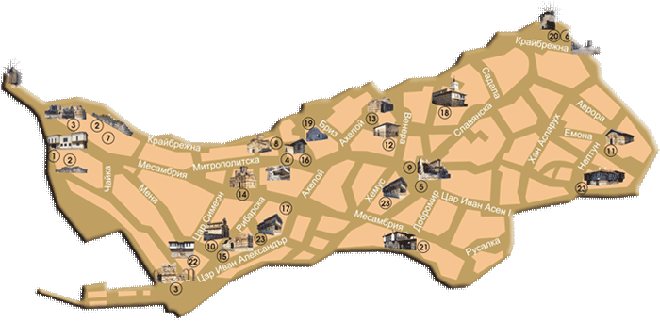
1. Archaeological museum (Nesebar)
Location: Mesemria street, Entrance to the Old City, Nesebar
Open: 9am- 7pm Mon- Fri, 9am- 1:30pm, 2- 6pm Sat- Sun June- Sept
9am- 6pm Mon- Fri, 9am- 1:30pm, 2- 6pm Sat- Sun May, Oct
9am- 12pm, 12:30- 5pm, closed Sat- Sun Nov- March
Entrance Fee: adults BGN 5, students BGN 3, groups BGN 4 per person
Archaeological museum of Nesebar stand near medieval walls at the entrance to the historic Nesebar on Mesembria Street. Archaeological museum of Nesebar was open fairly recently in 1994 in the Old Town. It contains collection of pottery, naval anchors, coins and many other ancient artefacts from the Thracian period when Greeks first settled Mesembria (Old Nesebar) and started to trade with the local tribes. You can see the UNESCO certificate which confirms that the city was designated a World Heritage Site since 1984. Additionally the museum has several medieval Christian icons in its possession. Most of them were painted or written (as artists call it) locally in Nesebar and surrounding villages.
2. Remains of the Greek wall in Nesebar (Nesebar)
Location: Entrance to the Old City of Nesebar
Ruins of military fortifications that once protected are spread throughout Nesebar. They were erected in the 5th century BC and later increased two centuries later. Parts of the ancient wall are discovered in different parts of the city, although the largest portion of the former fortifications are situated at the entrance of Nesebar. The main difference between Greek type of construction and later ancient Roman and Byzantine walls is the material that was used in their erection. While later owners of Nesebar used mortar and bricks, Greeks often used natural rocks that were quarried around the city.
3. Byzantium wall with towers (Nesebar)
Location: Entrance to the Old Town of Nesebar
Constructed: 7th century
Byzantine City walls or Western Walls of Medieval Nesebar once encircled the whole city. It protected the city against sea pirates as well as foreign armies. Today they are well preserved at the Western entrance to the Old Town of Nesebar.
The main entrance to the fortified city was protected by two pentagonal towers. Gates had two pairs of doors. One door had two parts and could be swung open, while another door could be lowered at night to seal Nesebar at night or during sieges. City walls were erected with use of special Byzantine masonry architectural style known as "opus mikstum" or mixed case. It consisted of layers of stone for strength and several layers of bricks for flexibility. As a result medieval military engineers managed to create large structures resistant to seismic activity like earthquakes that are common in the region. Since Nesebar city walls were created in the 7th century AD they underwent restoration only five times over course of twelfth centuries.
4. Early Byzantium baths (Nesebar)
Location: Mitropolitska street
Early Byzantine Baths of Nesebar are situated just behind the Church of Sveti Spas (or Saint Savior). These baths were constructed during the reign of Byzantine Emperor Justinian I the Great (483- 565). Chronicles of Saint Theophan and patriarch Nikifor state that in 680 AD these baths were visited by the Emperor Constantine IV Pogonatos ("the Bearded") who used its therapeutic powers. Historians claimed it was here that he "cured his legs". Unfortunately they were burned down and destroyed during Bulgarian invasion under leadership of Khan (Bulgarian ruler) Krum in 812 AD. Remaining parts were quarried by the locals to use in construction of other buildings. Part of the ancient complex that remained underground buried were spared from vandalism. Today it is all that remains from previously magnificent and impressive structure.
5. Basilica Saint Sophia aka the Old Bishopric (Stara Mitropoliya) (Nesebar)
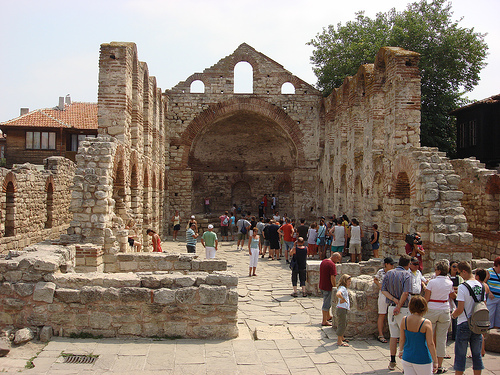
ulitsa (street) Mitropolitska
Old Bishopric or Cathedral of Saint Sophia in Nesebar was constructed in the 5th century on a site of a former ancient agora. It was part of a monastery, but the monastery was destroyed in the medieval times. Today it is part of the UNESCO World Heritage Site. The building has a semi- circular apse, a narthex and an atrium. It is 25 m (82 ft) long and 13 m (43 ft) wide. Unfortunately the frescoes and icons that once covered the sides of the structure were not preserved. Double sloped wooden roof with clay pieces covered the house of worship, but these were not preserved either. Judging by few remains the floor was also covered by colorful mosaics.
Much of damage was carried out by the Venetians in 1257 who captured Nesebar that was part of the Bulgarian Empire at the time. Despite being a Christian structure and a seat of Nesebar bishop, Basilica of Saint Sophia was completely looted. Its silver and golden objects were stolen and melted. The entrance is free as it is with most structures. Old Bishopric is particularly beautiful in the evening then sun rays of the setting sun hit the altar side of the church. The church still preserves a marble slab in one of its walls that quotes the Bible: "Hear my prayer, O Lord" (Psalm 102:1).
Friendly Warning
Medieval basilica of Nesebar is surrounded by various vendors, cafés and artists who sell their paintings. Try to avoid street food. People who sell it don't always follow hygiene procedures and various types of complications are quiet common after consuming their food. Many local also produce traditional objects and sell them here for a fairly low price.
6. Basilica Holy Mother of God Eleoussa (Nesebar)
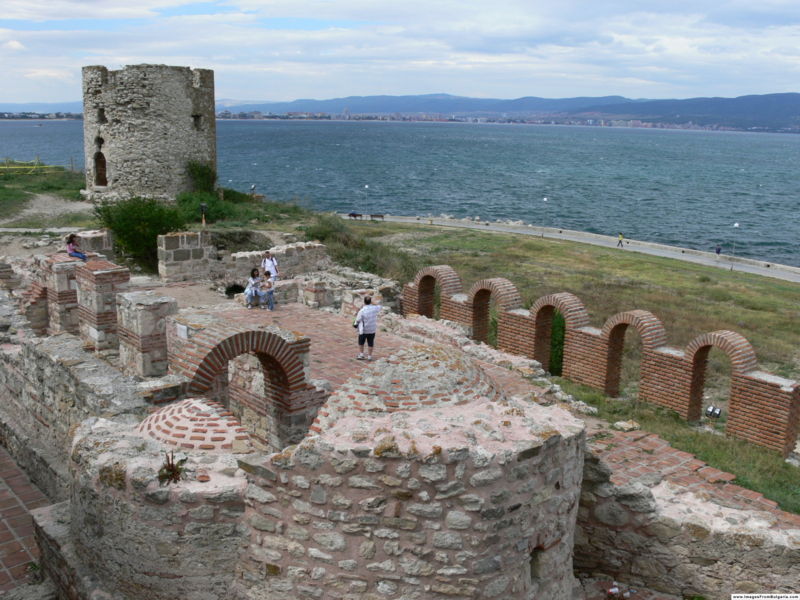
Location: Street Kraybrejna
Constructed: 5th- 6th century
Basilica of the Holy Mother of God Eleusa of Nesebar is a former monastery. "Eleusa" means "tender" in Greek thus the nickname of the Christian structure. The temple was constructed in the 6th century AD. It measures at 28 m long and 18 m wide with three naves, three apses and a nartex. Two side aisles also have two smaller apses that point in the North and South direction. It is a common architectural design of many medieval churches. It gave it basilica an appearance of a cross.
In the 14th century the monastery along with this part of the city sunk due to earthquake. In the early 20th century another earthquake struck the city lifting this part of the city while submerging other part of Nesebar. This the reason why the Basilica along with the defensive tower in the background lies slightly below the city streets. You can judge the depth to which it was submerged by looking at the tower stones. Lower levels of the tower are smooth due to sea water, while higher up level exposed to air are more rough and uneven.
7. Ruins of the early Christian Basilica and necropolis (Nesebar)
Location: street Kraybrejna (near entrance to the Nesebar Old City)
Constructed: 5th- 11th centuries
Christian Basilica of Nesebar was erected here in the 5th and 6th centuries. This imposing Christian temple it was reconstructed over a course of its history. Citizen of Nesebar buried their loved ones in the small cemetery or necropolis (literally "City of the dead" in Greek) near by. Most of the graves date back to the 10th and 11th century, which might suggest that bones of the previously deceased might have been moved to some other location within old Nesebar after a while. Or maybe archaeologists during their digs couldn't reach all part of the medieval areas out of fear that newer residence buildings might be damaged.
8. Church of John the Baptist (Nesebar)
Location: streets Mitropolitska and Kraybrejna
Constructed: 11th century
Cathedral of Saint John the Baptist of Nesebar was constructed in the 10th century. It measures 12 m long and 10 m wide. The structure has three semi- circular apses and no narthex. It is one of the best preserved churches in the city with its unique distinctly Bulgarian architectural style. The inside walls of the temple were plastered and artists used these white hard surface as a canvas for painting icons, portraits, animals and other items. The frescoes date from 14th century and other from 16th- 17th centuries. One of frescoes actually preserved faces of medieval citizens of Nesebar. One of the columns have later inscriptions that says: "Holy John, save me". The church is not functional. Today it contains an art gallery that is open to the public.
9. Remains of a cross like church (Nesebar)
Constructed: 10th century
Ruins of the Cross like building date back to the 10th century. It followed a usual Byzantine outline of the Christian structure. Bulgarians often mimicked this architecture of their neighbors to the East. Most of churches in Nesebar carry classic Byzantine appearance.
10. Church of Saint Stephen or the New Bishopric (Nova Mitropoliya) (Nesebar)
/3832975296_01955d1e12[1].jpg)
Location: Mena and tsar Simeon streets
Constructed: 11th century; reconstructed in the 16th-18th century
Open: 9am- 7pm Mon- Fri, 9:30am- 1:40pm, 2- 6pm Sat- Sun June- Sept
9am- 6pm Mon- Fri, 9am- 1:30pm, 2- 6pm Sat- Sun May, Oct
Closed: Nov- March
Entrance Fee: adults BGN 5, students BGN 3, groups BGN 4 per person
Cathedral of Saint Stephen or Stefan of Nesebar was constructed in the 11th century and was originally dedicated to Mother of God. It became known locally as a New Mitropoliya. The name implies that it was a seat of Mitropolit (second only to Patriarch) of Nesebar. It was reconstructed and increased in size in the 16th century. Its carved iconostasis dates back to 1599. The structure was constructed mostly from local stone and red brick for outside. This three nave basilica measures at 12 m long and 9.5 m wide. It follows the same basic design as the Old Mitropoliya with two aisles on each side. Marble columns give the basilica an elegant appearance. The cathedral also contains throne of the bishop dating back to Bulgarian Revival in the 19th century. Ancient frescoes were unfortunately destroyed. The ones that got preserved date back to the 16th- 18th centuries. There is about 258 of mural paintings that contain over 1000 figures from various scenes from the Bible. The facade of basilica contains images from the Apocalypses.
11. Church of Saint Theodore (Nesebar)
Constructed: 13th century
The church of Saint Theodore of Nesebar was constructed in the 13th century. The church is 8.70 m long and 4.15 m wide. It has an apse and a narthex. The construction of the church used local white limestone and black and red bricks. Today it serves as an art gallery.
12. Church of Saint Paraskeva (Nesebar)
Constructed: 13th- 14th century
Church of Saint Paraskeva of Nesebar is a Bulgarian Orthodox church that dates back to the 13th century. This medieval temple is currently recognized and protected by UNESCO. It is a single nave chapel and measures at 15 m long and 6 m wide. It has a nartex and a pentagonal apse. It was erected from red bricks and hewn stone. The altar portion also has glazed saucers of various colours build in the wall. Apparently the chapel had a bell tower in the medieval times, but it was destroyed. All that remains is a part of the stairwell that once led to the upper levels. Church of Saint Paraskeva is preserved in its original appearance. They only part that was added later is the wooden roof that was rotted and had to be changed repeatedly.
13. Church of the Holy Archangels Michael and Gabriel (Nesebar)
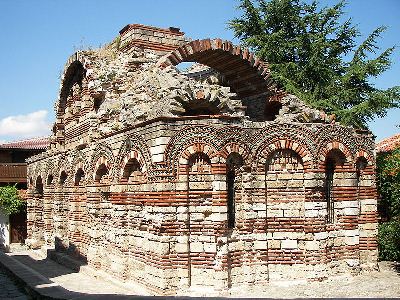
Constructed: 13th- 14th century
Church of the Holy Archangels Michael and Gabriel was constructed in the 1200s. Its heavenly protects Michael and Gabriel in the Eastern Orthodox tradition are included in the seven highest angelic spirits. On traditional Orthodox iconostasis they are portrayed on both sides of Jesus Christ, usually on the two side doors that led to the altar of the church. Archangel Michael is considered to the chief of angels and Gabriel as a guardian of the paradise and chief of angels that help people. Church of the Holy Archangels Michael and Gabriel of Nesebar is 14 meters long and 5 meters wide. Lack of care left the building in a bad state so much of the roof and a dome have collapsed after years of negligence and abandonment. Today religious services are no held in Church of the Holy Archangels Michael and Gabriel of Nesebar, but it is open to the public. Its remains are protected by a UNESCO.
14. Church of Christ Pantocrator (Nesebar)

Constructed: 13th- 14th century
Church of Christ Pantocrator of Nesebar is included on the list of cultural and historical sites of UNESCO. Church of Christ Pantocrator was constructed in the 1200's. It is one of the best preserved medieval church in the city as well as all of Bulgaria. It measures 16 meters long by 7 meters wide. It has three apses and two entrances, on the South and North side of the building. The building was constructed from pieces of red bricks and local white limestone. Much of the plaster was lost along with medieval frescoes that covered them. Three small richly profiled apses are located on the eastern side. A square bell tower rises above the porch. The roof of Church of Christ Pantocrator of Nesebar is an octagonal tower with arched windows. Today the building is converted to a picture gallery. Church of Christ Pantocrator of Nesebar was included in the list of UNESCO's cultural and historical heritage.
15. Church of Saint John Aliturgetos of Nesebar (Nesebar)
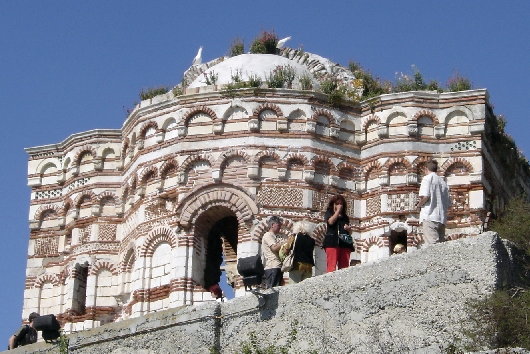
Constructed: 14th century
Church of Saint John or Ioan of Nesebar is one of the most colorful religious structures on the island of Nesebar. It was constructed in the 14th century. It is 10 m wide and 19 m long with two entrances in the North and South sides of the church. It is an usual feature for the Bulgarian Christian temples of the medieval period. Its name "aliturgetos" means "without a liturgy" in Greek. According to a legend a local man worked here during construction, slipped and fell to his death. Religious officials did not allow to consecrate Nesebar church because of this tragic event. Although certain services were held here, the main service of liturgy was never performed here. It basically served more of the prayer house rather than a real church. This church has traditional three altar apses and a narthex. It was heavily damaged during Chirpansko earthquake in 1913 that ended its use as a Orthodox Christian Church. Today it is more of the museum. On the remains of the Western wall, opposite of the altar you can find drawings of the ships that date back to the 1300's. The floor of the church is covered by mosaics from white, red and green squares, circles and triangles.
16. Church of Saint Spas of Nesebar (Nesebar)
Constructed: 1609
Open: 10- 5pm Mon- Fri, 10am- 4pm Sat- Sun
June- Sept
10am- 5pm Mon- Fri, 10am- 3pm Sat- Sun May, Oct
Closed: Nov- March
Entrance Fee: adults BGN 3, students BGN
2, groups BGN 2.50 per person
Saint Spass (Savior) Church of Nesebar dates back to the 1600's. It was one of the few churches that were constructed in Nesebar during rule of the Ottoman Turks. Christians were allowed to erect their house of worship as long as it did not stand out in the city. This explains its fairly modest and simple outside look. You might pass it without realization that it is actually a Christian Church. It has a single nave and a single apse. It measure 12 meters by 6 meters. Inscriptions that are found over South entrance states that frescoes were painted during life of Bishop Kiprian (head of Nesebar seat) in 1609. It is one of the best preserved murals that survive in Nesebar churches. In particular Virgin Platutera in the apse of the church is remarkable. Additionally you can find a tombstone of a Byzantine princess Mataissa Cantacuzina who is buried here. She was originally entombed in the New Metropolitan (Metropoliiya) church in 1441, but later coffin with her remains was moved here by the orders of the bishop of Nesebar. Today the church serves as a museum of the city.
17. Church of Saint Clement of Nesebar (Nesebar)
Constructed: 17th century
Church of Saint Clement was constructed in Nesebar in the 1600's. Many of its beautiful frescoes are well preserved and clearly visible despite lack of any restoration.
18. Church of Virgin Eleusa (Nesebar)
Constructed: 1873
Church of Saint Mary or Assumption of a Virgin of Nesebar is one of the few active Bulgarian Orthodox Churches in Nesebar that was constructed in 1873. It is operational and services are held inside.
20. Nesebar Windmill (Nesebar)
Constructed: 18th century
Windmill that is found at the entrance to the Nesebar Old Town have been preserved since the 1700's. Location of the town allowed constant fresh sea breeze to keep the mill working.
19. Turkish baths (khamam) in Nesebar (Nesebar)
Constructed: 18th century
Turkish baths or khamam or hamam of Nesebar were constructed in the 1700's at the time when the country was ruled by the Ottoman Turkish Empire. It was an important place for men of Nesebar to met, socialize and discuss serious matters of the state and personal business. Today they are left abandoned and closed. yet they are in a good state of preservation.
21. The house of Moskoyani- Ethnographic museum (Nesebar)
Constructed: 1840
Open: 10:30am- 1:30pm, 2- 6pm Tue- Sun June- Sept
10:30am- 1:30pm, 2- 6pm May- Oct
Closed: Mondays, Nov- March
Entrance Fee: adult BGN 3, student BGN 2, groups BGN 2.50 per person
The house of Moskoyani- Ethnographic museum is dedicated to traditional life of residents of Nesebar.
22. The house of Captain Pavel (Nesebar)
Constructed: 19th century
This is a former residence of a notable folk hero that was preserved since the 19th century.
23. Ensembles of houses of the Bulgarian National Revival in Nesebar (18th- 19th century) (Nesebar)
Houses of the Old City quarters is a special component of unique
Bulgarian feel. Residents of the settlement constructed their
homes as a two story building. The first floor was made mostly
from stone and rocks and was reserved for the economic purposes.
Today many of them are turned into restaurants, hotels, hostels,
small shops with souvenirs and etc. The second story was made
mostly from wood and was considered a residential part of home.
The second floor is usually slightly bigger in area so it appear
to hang over the streets outside. Local claim that it was a
smart way for Bulgarian Christian citizens to escape heavy taxes
of the Ottoman Turkish Empire that burdened them. Property and
real estate taxes only taxed land underneath the fist floor of
the house. Home owners purposefully made it slightly smaller,
while the second floor could be made slightly larger to escape
extra levies and government taxes.
This is only part of
destinations that are located in the Old City of Nesebar. Every
year archaeological digs uncover something new and interesting
in this city. Just recently archaeologists discovered a burial
of an ancient Greek woman that dates back to the third century
BC. Her massive stone sarcophagus was opened by scientists and
there they discovered remains of a influential aristocratic
woman along with her most valuable possessions including golden
ear rings in a shape of a lion head. Other finds include bronze
mirror and pottery that probably contained perfumes, food and
water for the afterlife.
In 2003 construction workers were
working in the sewage system underneath the city. There they
accidentally discovered a whole ancient temple after one of the
walls have collapsed. Archaeologists estimated that this pagan
religious complex was constructed in the second century before
birth of Christ. We can guess what other mysteries and secrets
are hiding below medieval streets.
New Nesebar |
Aqua Paradise Aqua park (Nesebar)
Aqua Paradise is the largest water park in Bulgaria with its total area of 30,000 feet. It contains 40 water slides and other attractions. It was recently opened in 2006 in the New part of the city and significantly expanded in 2009. In addition to water pools and slides Aqua Paradise Aqua park houses a coffee bar and a restaurant with international cuisine. The park is open between May 21st and September 14th.
Mineral water spring "Geranite (Nesebar)
Mineral water springs "Geranite" is situated near a North beach. They were famous for its homeopathic medical benefits since the ancient times. They are available to tourists and you can try on your own. Local legends claim that "Geranite" is only visible part of the underground river that flows through a cave. Some locals even claimed to have descended to that underground water system and even discovered ancient Roman coins. Whether truth of fiction, but local residents are absolutely certain that health benefits of "Geranite" is owed due to a large treasure buried by the Roman legionnaires at the source of water springs.
Practical Information about traveling to Nesebar |
Nesebar WeatherThe weather is Nesebar is warm and stable. In summers the average temperature is at the high 70's F. In winter months it rarely goes below freezing point. The best time to visit Nesebar is between May and October. The driest months of the year usually lasts between July and August. While many tourists flock to the city in the early and middle of summer it might be wise to visit this destination in August and September. The heat is more bearable in these months, while crowds of visitors have subsided. |
Transport in NesebarMost of the Nesebar Old City is not accessible by anything larger than a small sedan. Some of the streets are even narrow than that. So the best way to explore Nesebar is by walking around by foot. Most of the city is situated on a peninsula with relative little elevation so you don't have to walk up and down all day. However you should keep in mind that during summer months the weather might become difficult to bear. So keep well hydrated, wear sun tan and cover your head.
|
Health and safety in NesebarKeep an eye on what you eat and what you drink while you travel in Nesebar. Avoid consuming food outside of restaurants and well respected places. You don't want to get complications due to careless food vendor who doesn't follow simple hygiene procedures. Also don't forget to take bottled water at all times. The climate in Nesebar in summers can be very hot and well hydration is essential. As you walk through narrow streets you can also encounter small water fountains that are known locally as Cheshma (pictured above on the left). It is up to you whether you want to risk your health and use it. |
|
Nesebar is surrounded by water so it is not surprising that sea food makes up much of the local cuisine. It is certainly worth a try. Although I can not pass without mentioning the best soup I've ever tried. It is called Shkembe Chorba. It is made of lamb intestines and usually require some vinegar to add. Now it might seem unpleasant and probably gross, but it is without a doubt one the best foods I've tried in my life. Unlike muscle meat, intestines are not as rough. The gentle meat just melts in your mouth.